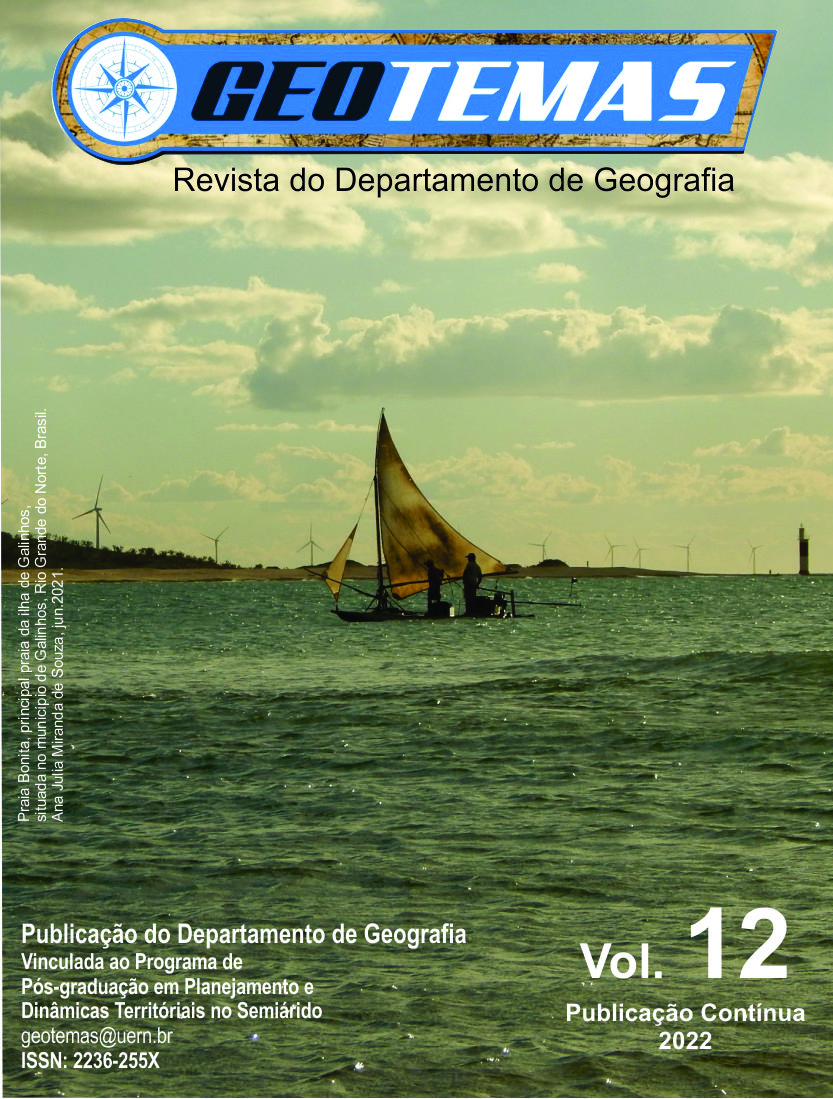Use of groundwater and the health situation of captures in abolição neighborhood, Mossoró/RN
DOI:
https://doi.org/10.33237/2236-255X.2022.4243Keywords:
Water Supply System, Açu Aquifer, Tubular Wells, Urban WatersAbstract
In the municipality of Mossoró/RN about 70% of the demand for the Sistema de Abastecimento de Água (SAA) is met by the groundwater of the Açu Aquifer through capture via tubular wells. The place searched corresponds to a neighborhood located in the urban area of the municipality of Mossoró, identified as Abolição (Abolição I, II, III, IV and V). Due to its great importance for the supply of groundwater, in which it is intended for the consumption of the population, regular monitoring is necessary to obtain data, which aim to support the management process of the aquifer located under the city. Thus, this work aims to characterize the use and capture of groundwater in the Abolição neighborhood and analyze the situation of the catchment works. Therefore, secondary data from the Sistema de Informação de Águas Subterrâneas – SIAGAS and Companhia de Água de Esgoto do Estado do Rio Grande do Norte – CAERN and primary data from a field step. The capture occurs 100% through tubular wells that have a depth between 140 meters and 1,000 meters, in addition, it was possible to identify that about 56% of the wells are inactive in the study area. The research seeks to contribute to the updating of important information in the management of local groundwater, in order to provide improvements in the process of catchment use.
Downloads
References
ASSOCIAÇÃO BRASILEIRA DE NORMAS TÉCNICAS. NBR 12.212: Projeto de poço para captação de água subterrânea. Rio de Janeiro, p. 5, 1992. Disponível em: http://licenciadorambiental.com.br/wp-content/uploads/2015/01/NBR-12.212- Projeto-de-Po%C3%A7os-Para-Capta%C3%A7%C3%A3o-de-%C3%81guas- Subterr%C3%A2neas.pdf. Acesso em: 08 fev. 2022.
ASSOCIAÇÃO BRASILEIRA DE NORMAS TÉCNICAS. NBR 12.244: Construção de poço para captação de água subterrânea. Rio de Janeiro, p. 6, 1992. Disponível em: http://licenciadorambiental.com.br/wp-content/uploads/2015/01/NBR-12.244- Construc%C3%A3o-de-po%C3%A7o-para-capta%C3%A7%C3%A3o-de-
%C3%A1gua-subterr%C3%A2nea.pdf. Acesso em: 08 fev. 2022.
CAERN, Companhia de Águas e Esgotos do Rio Grande do Norte, 2022. Disponível em: http://www.caern.rn.gov.br/, acesso em 09 de fev, 2022
CPRM – SERVIÇO GEOLÓGICO DO BRASIL. Noções básicas sobre poços tubulares: cartilha informativa. 1998, p. 1-22. Disponível em: https://rigeo.cprm.gov.br/xmlui/bitstream/handle/doc/16636/Nocoes_Basicas_Pocos_ Tubulares.pdf?sequence=1&isAllowed=y. Acesso em: 08 fev. 2022.
CUPUCCI, E. et al., Poços tubulares e outras captações de águas subterrâneas: orientação aos usuários. Rio de Janeiro: SEMADS, 2001, p. 2-66. Disponível em: http://www.bibliotecaflorestal.ufv.br/bitstream/handle/123456789/3924/Livro_Po%c3
%a7os-Tubulares-e-Outras-Capta%c3%a7%c3%b5es-de-%c3%81guas- Subterr%c3%a2neasOrienta%c3%a7%c3%a3o%20Aos%20Usu%c3%a1rios_SEMA DS-RJ.pdf?sequence=1&isAllowed=y. Acesso em: 08 fev. 2022.
DE ASSIS, J. C. Água sob medida. Agroanalysis, v. 18, n. 3, p. 63-66, 1998.
FEITOSA, F. A. C. [et al.]. Avaliação dos Recursos Hídricos Subterrâneas. In: FEITOSA, Fernando A. C. [et al.] (organizadores). Hidrogeologia: conceitos e aplicações. 3º ed. Rio de Janeiro: CPRM: LABHID, 2008. p. 661-669. Disponível em:<https://rigeo.cprm.gov.br/xmlui/handle/doc/14818> Acesso em 17 ago. 2021
FREITAS, M. F.; CRUZ, F. D. O. Abolição: da segregação à valorização do maior conjunto habitacional da Cohab/RN. Natal: XVII ENANPUR, 2019, p. 1-18.
HIRATA, R. et al. As águas subterrâneas e sua importância ambiental e socioeconômica para o Brasil. São Paulo: Universidade de São Paulo/Instituto de Geociências, 2019. Disponível em:
<https://igc.usp.br/igc_downloads/Hirata%20et%20al%202019%20Agua%20subterra nea%20e%20sua%20importancia.pdf>. Acesso em: 18. ago. 2021.
HERRAIZ, A. S. La importancia de las aguas subterráneas. Revista de la Real Academia de Ciencias Exactas, Físicas y Naturales, v. 103, n. 1, p. 97-114, 2009. Disponível em: <https://www.dipucadiz.es/export/sites/default/transicion-ecologica-y-desarrollo-urbano- sostenible/.galeria_de_ficheros/docu_cursos_jornadas/jornada-agua-subterranea/informacion_general/Importancia-de-las-aguas-subterraneas.pdf>.
Acesso em: 23 ago. 2021.
INSTITUTO BRASILEIRO DE GEOGRAFIA E ESTATÍSTICA – IBGE. Censo demográfico: domicílios particulares permanentes por situação e número de moradores. Rio de Janeiro: IBGE, 2010. Disponível em: https://sidra.ibge.gov.br/Tabela/185. Acesso em: 24 fev. 2022.
INSTITUTO BRASILEIRO DE GEOGRAFIA E ESTATÍSTICA – IBGE. Panorama de cidades. Rio de Janeiro: IBGE, 2021. Disponível em: https://cidades.ibge.gov.br/brasil/rn/mossoro/panorama. Acesso em: 09 dez. 2021.
MOURÃO, M. A. A. et al. Fundamento para implantação da rede básica nacional de monitoramento integrado das águas subterrâneas. 2009. Disponível em: https://www.abrhidro.org.br/SGCv3/publicacao.php?PUB=3&ID=110&SUMARIO=2 260. Acesso em: 30 set. 2021.
OLIVEIRA JUNIOR, H. S.; SILVA, P. C. M.; SILVA, C. L. C. Monitoramento e mapeamento das águas subterrâneas de abastecimento urbano do município de Mossoró-RN. Revista Brasileira de Geografia Física, v. 09, n. 06, p.1805-1835, 2016.
PEIXOTO, F. DA S.; OLIVEIRA, J. P. DE; SANTOS, H. D. C. DOS. O ESGOTAMENTO SANITÁRIO E EXPANSÃO URBANA EM MOSSORÓ-RN. Sociedade e Território, v. 33, n. 2, p. 189-211, 30 dez. 2021.
REBOUÇAS, A., FILHO, M. & BENOIT, H. Bacia Potiguar - Estudo Hidrogeológico. SUDENE - Divisão de Documentação, Recife, 1967.
SIAGAS - Sistema de Informações de Águas Subterrâneas. 2021. Disponível em: http://siagasweb.cprm.gov.br/layout/. Acesso em: 8 out. 2021.
SOTERO, A. DE ARRUDA MOREIRA. O esgotamento sanitário em Natal/RN: Configuração territorial e implicações socioespaciais. Revista de geografia (Recife), v. 28, n. 2, p. 44-59, 2011.
TÔRRES, L. M. G. Análise do uso e captação das águas subterrâneas no bairro Bacurau 1, Apodi/RN. Trabalho de conclusão de curso – Curso de Geografia, Faculdade de Filosofia e Ciências Sociais, Universidade do Estado do Rio Grande do Norte, Mossoró, 2022.
TSUTYIA, M. T. Abastecimento de água. 3. ed. São Paulo: Departamento de Engenharia Hidráulica e Sanitária da Escola Politécnica da Universidade de São Paulo, 2006. p. 643.
ZOBY, J. L.G. Panorama da qualidade das águas subterrâneas no Brasil.2008 Disponível em: <https://aguassubterraneas.abas.org/asubterraneas/article/view/23802>. Acesso em: 27 set. 2021.
Downloads
Published
How to Cite
Issue
Section
License
Copyright (c) 2022 JOURNAL GEOTEMAS

This work is licensed under a Creative Commons Attribution-NonCommercial 4.0 International License.
Authors who submit their manuscripts to Geotemas declare that the work is an original article and has not been submitted for publication, in full or in part, in another national or international scientific journal or in another circulation vehicle. The authors also declare that they agree with the transfer of the copyright of the referred article to the magazine Geotemas (University of the State of Rio Grande do Norte), allowing for later publications, as long as the source of its publication is assured. Finally, they assume public responsibility for the article, being aware that any charges arising from a claim by third parties regarding the authorship of the work may apply to them.



















